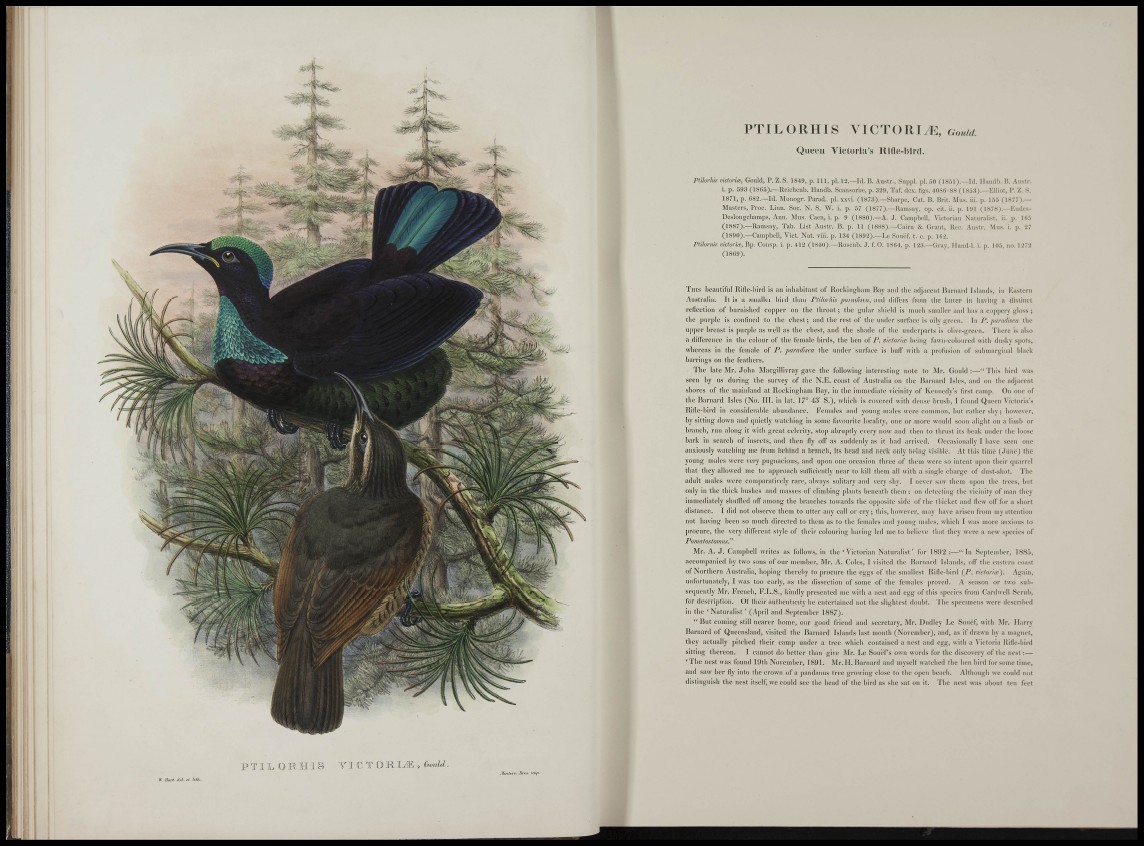
PTILORHIS VICTORIyi:,
Queen Victoria's Rifle-bird.
P l i l m - h i s m d m - m , Gould, P. Z. S. 1849, p. I l l , pi. 12.-1,1. B. Austr., Suppl. pi. 50 (18.^)1).—Id. 1 hu.dli. 15. Aiistr.
i. p. 593 (1806).—Reichcnb. Ilandb. ScansorLffi, p. 321), Taf. dcx. Hgs. -lOSC-S» (1853;.—Elliot, 1'. Z. S.
1871, p. G82.—Id. Monogr. Parad. pi. xxvl. (1873).—Sharpc, Cat. H. lirit. Mus. iii. p. ir,r> (1H77).—
Masters, Proc. Linn. See. N. S. \V. i. p. 57 (1877).—Ramsay, op. cit. ii. p. 191 (1878).-Kiidcs-
Deslongchamps, Ann. Mus. Caen, i. p. 9 (1880).—A. J. Campbdl, Victorian Naturalist, ii. p. 105
(1887).—Ramsay, Tab. List Austr. B. p. 11 (1888).—Cairn & Giant, Rcc. Austr. Mus. i. p. 27
(1890).—Campbell, Vict. Nat. viii. p. 134 (1892).—Le Soucf, t. c. p. 102.
P t i l o n n s victoriie. Bp. Consp. i. p. 4 12 (1850).—Rosenb. J. f. 0 . 1S(Ì4, p. 12:).—Gi ay. 1 Iaiid-1. i. p. 10.5, no. 1 ì l i
(1809).
THIS beautiful RiBc-l)ii-(l is an inhabitant of liockingliani Bay and tliu adjaccnt ISiirnaril Islands, in Eastern
Australia. It is a smaller bird llian Pt l lorhh p n m d k c a , and dilfers from the latler in having a ilistinct
reflection of burnished copper on the throat; the gular shield is nmcli .smaller and has a coppery gloss ;
the purple is confincd to the chest; and the rest of tlie under surface is oily green. \n P . p a r a i l i s c i i the
upj)cr breast is purjile as well as the chest, and the sliade of the uiiderparts is olive-greeu. There is also
a difference in the colour of the female birds, the hen of P . v i c t o r i a ! being fawn-coloured with dusky spots,
wliereas in the female of P . p a r a d i s c a ihe under surface is bnlf with a profusion of suhmarginal black
barrings on the feathers.
The late Mr. John Macgillivray gave the following Interesting note to Mr. Gould :—" Tliis bird was
seen by us during the survey of the N.E. coast of Australia on the liarnard Isles, and on the adjacent
shores of the maiidand at Rockingham 15ay, in the immediate vicinity of edy's first camp. On one of
the Barnard Isles (No. III. in lat. 17° 43' S.), wliicli is covereil with dense brush, I found Queen Victori¿l's
KKIe-blrd in considerable abundance. Females and young males were common, but rather shy; however,
by sitting down and quietly watching in some favourite locality, one or more would soon alight on a llnii) or
branch, run along it with great celerity, sto]) abrujjtly every now and then to tlirust its beak under the loose
bark in search of insects, and then fly off as suddenly as it had arrived. Occasionally I have seen one
an.itlously watching me from behind a branch, its head and neck only Ijelng visible. At this time (.June) the
young males were very pugnacious, and upon one occasion three of them were so intent upon their quarrel
that they allowed me to approach suHieiently near to kill them all with a single charge of dust-shot. The
adult males were comparatively rare, always solitary ami very shy. I never saw then] njion the trees, but
only in the thick bushes ami masses of climbing plants beneatli them : on detecting tlie vicinity of man they
immediately shuffled off among the branches towards the opposite side of the thicket and flew off for a short
distance. I did not observe them to utter any call or cry; this, however, may have arisen from my attention
not having been so much directed to them as to the females and young males, which I was more anxious to
]irocure, the very different style of their colouring having led me to believe that they were a new species of
Pomatostomus"
Mr. A. J . Campbell writes as follows, in the 'Victorian Naturalist' for 1892 :—" In September, 1885,
accom|)anied by two sons of our member, Mr. A. Coles, I visited the Barnard Islands, off the eastern coast
of Northern Australia, ho|)ing thereby to ]u-ocure the eggs of the smallest Kifle-bird { P . mclori tc) . Again,
unfortunately, I was too early, as the dissection of some of the females proved. A season or two subsequently
Mr. French, F.L.S., kindly presented me with a nest and egg of this species from Cardwell Scrub,
for description. Of their authenticity lie entertained not the slightest doubt. The specimens were described
in the 'Naturalist' (April and September 1887).
" But coming still nearer home, our good friend and secretary, Mr. Dudley Le Soiief, with .Mr. Harry
Barnard of Queensland, visited the Barnard Islands last month (November), and, as if drawn by a magnet,
they actually ])itclied their camp under a tree which contained a nest and egg, with a V ictoria liifle-hird
sitting thereon. I cannot do better than give Mr. Le Souths own words for the discovery of the nest:—
' The nest was found 19th November, 1891. Mr. H. Barnard and myself watched the hen bird for some time,
and saw her fly into the crown of a ])andiinus tree growing close to the open beach. Although we could not
distinguish the nest itself, we could see the head of the bird as she sat on it. The nest was about ten feet
IV. iJ^i/V iUI. ft IHÌ' •
P T I L ii) R H i 8 TI C T O R I J E , 0 ,mlJ .
.yiiLirrii //ow. '"'/'•